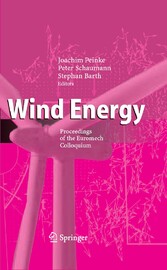Suchen und Finden
1 Offshore Wind Power Meteorology (p. 1-2)
Bernhard Lange
Summary. Wind farms built at offshore locations are likely to become an important part of the electricity supply of the future. For an efficient development of this energy source, in depth knowledge about the wind conditions at such locations is therefore crucial. Offshore wind power meteorology aims to provide this knowledge. This paper describes its scope and argues why it is needed for the efficient development of offshore wind power.
1.1 Introduction
Wind power utilization for electricity production has a huge resource and has proven itself to be capable of producing a substantial share of the electricity consumption. It is growing rapidly and can be expected to contribute substantially to our energy need in the future (GWEC, 2005). The ‘fuel’ of this electricity production is the wind. The wind is, on the other hand, also the most important constraint for turbine design, as it creates the loads the turbines have to withstand.
Therefore, accurate knowledge about the wind is needed for planning, design and operation of wind turbines. Some tasks where speci.c meteorological knowledge is essential are wind turbine design, resource assessment, wind power forecasting, etc. Wind power meteorology has therefore established itself as an important topic in applied meteorology (Petersen et al., 1998). For wind power utilization on land, substantial knowledge and experience has been gained in the last decades, based on the detailed meteorological and climatological knowledge available. Offshore, the meteorological knowledge is less developed since there has been little need to know the wind at heights of wind turbines over coastal waters and any measurements at offshore locations are di.cult and extremely expensive.
The aim of this paper is to describe the scope of offshore wind power meteorology and to argue why this topic should be given more attention both from the meteorological point of view and from the wind power application point of view. The paper is structured in three main sections: First some particular problems of offshore measurements are discussed in Sect. 1.2. This is followed by a section giving examples for meteorological effects specific for offshore conditions. Their importance for wind power application is shown in Sect. 1.4, followed by the conclusion.
1.2 Offshore Wind Measurements
In recent years, measurements with the aim to determine the wind conditions for offshore wind power utilization have been erected at a number of locations (Barthelmie et al., 2004). Offshore wind measurements are a challenging task, not only since an offshore foundation and support structure for the mast are needed, but also because of the challenges to provide an autonomous power supply and data transfer, the difficulties of maintenance and repair in an offshore environment, etc. These difficulties lead to high costs of offshore measurements and often lower data availability compared to locations on land. Additionally, the flow distortion of the self supporting mast usually requires a correction of the measured wind speeds for wind profile measurements (Lange, 2004).
Two measurements, from which results are shown in this paper, are the Rødsand field measurement in the Danish Balitc Sea and the FINO 1 measurement in the German Bight.
Alle Preise verstehen sich inklusive der gesetzlichen MwSt.









